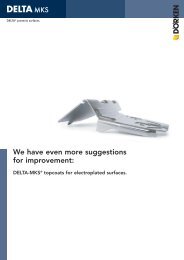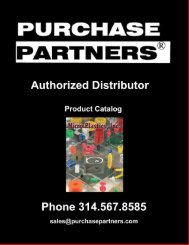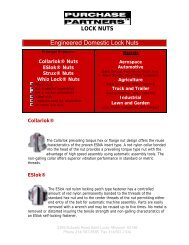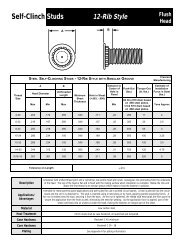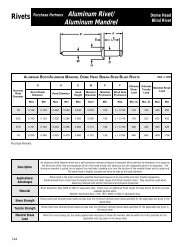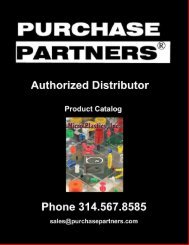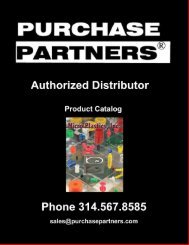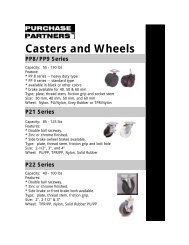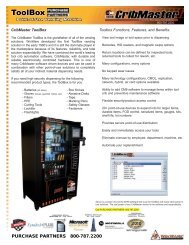Assembly Parts - Purchase Partners
Assembly Parts - Purchase Partners
Assembly Parts - Purchase Partners
You also want an ePaper? Increase the reach of your titles
YUMPU automatically turns print PDFs into web optimized ePapers that Google loves.
Definitions<br />
A caster is usually measured by the size of its wheel. For example, a 3" caster<br />
would have a 3" wheel -- even though the total overall height of the unit is more<br />
than 3" tall. Casters come in two basic types: Swivel and rigid. Some manufacturers<br />
also call the rigid "fixed" or "stationary" -- which is not a good term for something<br />
that is supposed to move. Casters are mounted using fastenings -- usually a<br />
plate that is bolted or welded in place, or a stem that is inserted into tubing.<br />
Axle. The bolt that runs through the wheel and through the swivel (a.k.a. "kingpin.").<br />
Bearing. A bearing is the moving part that allows the caster to move. It refers to both<br />
the swivel bearing (a.k.a. raceway), and wheel bearing.<br />
Bolt Holes. The holes in the top plate allowing the caster to be mounted on the cart.<br />
Bore. The hole through the middle of a wheel. Also a very tedious person.<br />
Brake. Just like the emergency brake on a car -- when applied, it helps prevent the wheel<br />
from rolling.<br />
Capacity. Also known as load capacity -- the weight the caster will safely hold.<br />
Caster. A wheel on a swivel, attached under a piece of furniture or other heavy object to<br />
make it easier to move. (The dictionary came up with this definition, not us.)<br />
Diameter. The wheel diameter of a caster.<br />
Fastening. The method of mounting a caster to the furniture or cart (i.e., top plate,<br />
threaded stem, etc.).<br />
Hub. The center core of a wheel.<br />
Hub Length. The length of the bore of a wheel. The hub length is usually wider than the<br />
tread.<br />
Kingpin. The axle that holds the fastening to the caster body and allows the unit to<br />
swivel.<br />
Load Capacity. Also known as capacity -- the weight the caster will safely hold.<br />
Overall Height. The total vertical height of the caster, from the floor to the top of the<br />
mounting plate, or the base of the stem.<br />
Rigid. A caster that doesn't swivel, but still rolls forward and back. Also known as a<br />
"fixed" or "stationary" caster.<br />
Stem. A fastening that usually fits into tubing for the caster to be mounted.<br />
Swivel Lock. Just like it sounds: It locks the swivel, making the caster act as a rigid.<br />
Swivel Raceway. One or two rows of ball bearings which bear the weight of the caster and allow<br />
the unit to swivel.<br />
Swivel Radius. The horizontal distance from the center of the kingpin to the trailing edge of the<br />
wheel. This determines the "sweep" of a caster as it pivots -- a good thing to know to make sure the<br />
wheel doesn't strike something as it turns.<br />
Thread Guard. A small piece of metal or plastic that fits over the wheel bearing to help prevent<br />
threads, dirt, and other materials from getting into the wheel. Note the spelling -- thread guard, not<br />
tread. Big difference.<br />
Tread. The part of the wheel that rolls on the ground. Not to be confused with "thread".<br />
Tread Width. The width of the wheel tread.



